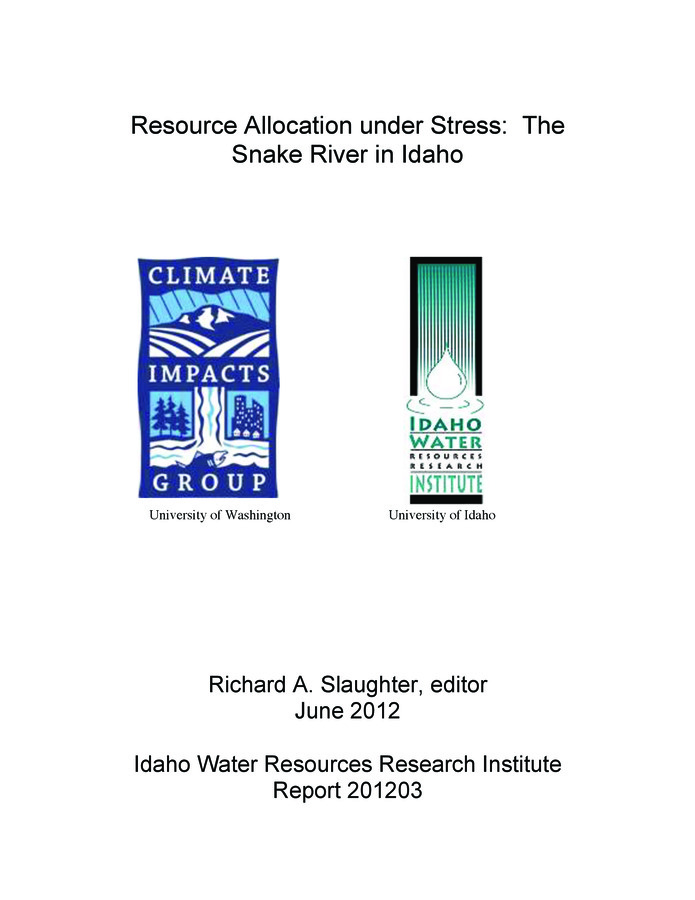PDF
Resource allocation under stress: the Snake River in Idaho Item Info
- Title:
- Resource allocation under stress: the Snake River in Idaho
- Authors:
- Slaughter, Richard A.
- Date Created (ISO Standard):
- 2012-06-25
- Description:
- The debate over management of and adaptation to climate change tends to focus on expert regulation vs. private exploitation. A third path is available: an institutional set in which preferred behaviors are automatically encouraged by shared resource ownership. In water, for example, users can be joint owners of a resource rather than customers of a utility or subject to a regulatory agency. User behavior differs markedly between the two situations. This book is a study of the Snake River as an example of informal, multi-faceted governance under conditions of growth, climate variability, and changing social preferences. The participants in the story include surface and groundwater irrigators, the State of Idaho, the Idaho legislature, federal agencies, Congress, the President of the United States, the judicial system, and native tribes. While many of the entities involved are governmental agencies, they do not possess formal regulatory authority over use of the River or allocation of its water. They are more like participants in a multifaceted social contract, in which each has claims but none is in a controlling position, and are caught up in an ongoing dance over allocation and use. In this dance, the judicial system acts as an outside constraint and motivator, but because of its own inefficiencies not as a determining player in the outcome. The implications of climate change for water resources raise the question of how well water institutions in the Western United States might be expected to adapt to changed volume or timing of water flows. Particularly in basins where snowpack provides substantial storage, late season flows will be significantly reduced and underground recharge from slowly melting snow will also be reduced. Within that context, it would be helpful to develop an understanding of what institutional structures are conducive to adaptation, and to what extent new or changed institutions might be required or expected to emerge. This study examines these questions in the context of the Snake River in southern Idaho. The Snake provides a useful case study for several reasons: it lies almost entirely within a single state, Idaho, and thus within a single water law jurisdiction; it is coupled with an extensive aquifer, providing complexities of hydrologic and legal interaction that make it a complete case; and the water law underlying Snake River water allocation is based in the prior appropriation doctrine, providing a test of whether that doctrine continues to be useful. A Snake River study has another value as well. The Snake history encompasses a major shift of public-policy preference from development of the West (19th and early 20th centuries) to protecting environmental values from development pressure (late 20th century). During the period of development priority, public policy explored several public and private models to realize the scale economies required for irrigation and hydropower. Simultaneously, institutional innovations were required to deal with climate variability, primarily in the form of drought. Finally, as the river became fully appropriated and public preferences changed in the late 20th century, institutions had to deal with changes in use and resource scarcity in the context of a growing population and changing economy. The contents cover evolution of the system and governance; policy tools developed by the University of Idaho and the Idaho Department of Water Resources to assist management of water rights; special problems posed by conjunctive use of ground and surface water; and case studies in the ongoing institutional development to accommodate change.
- Subjects:
- water supply water resources development irrigation water Snake River water use water resources development -- Idaho -- Government policy water in agriculture appropriation irrigation appropriation climate adaptation institutional adaptation water resource development social policy development governance property rights
- Location:
- Snake River
- IWRRI number:
- 201203
- Rights:
- In copyright, educational use permitted. Educational use includes non-commercial reproduction of text and images in materials for teaching and research purposes. For other contexts beyond fair use, including digital reproduction, please contact the University of Idaho Library Special Collections and Archives Department at libspec@uidaho.edu. The University of Idaho Library is not liable for any violations of the law by users.
- Publisher:
- University of Idaho
- Contributing Institution:
- University of Idaho
- Type:
- Text
- Format:
- application/pdf
- Cataloger:
- Jodi Haire
- Date Digitized:
- 2012-06-27
Source
- Preferred Citation:
- "Resource allocation under stress: the Snake River in Idaho", Idaho Waters Digital Library, University of Idaho Library Digital Collections, https://www.lib.uidaho.edu/digital/iwdl/items/iwdl-201203.html
Rights
- Rights:
- In copyright, educational use permitted. Educational use includes non-commercial reproduction of text and images in materials for teaching and research purposes. For other contexts beyond fair use, including digital reproduction, please contact the University of Idaho Library Special Collections and Archives Department at libspec@uidaho.edu. The University of Idaho Library is not liable for any violations of the law by users.
- Standardized Rights:
- http://rightsstatements.org/vocab/InC-EDU/1.0/

